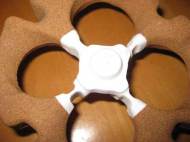Hybrid ceramic-sand core casting technology
 In a joint effort with Grainger and Worrall Ltd. of the United Kingdom, the researchers at the Southwest Research Institute (SwRI) developed a novel casting technology that could be used for production of heavy-duty diesel engines with a higher peak cylinder pressure capability than current state-of-the-art engines. The technology has received a 2012 R&D 100 Award as one of the 100 most significant technological achievements of the past year.
In a joint effort with Grainger and Worrall Ltd. of the United Kingdom, the researchers at the Southwest Research Institute (SwRI) developed a novel casting technology that could be used for production of heavy-duty diesel engines with a higher peak cylinder pressure capability than current state-of-the-art engines. The technology has received a 2012 R&D 100 Award as one of the 100 most significant technological achievements of the past year.
Southwest Research Institute’s Hybrid Ceramic-Sand Core Casting Technology combines aerospace ceramic and automotive sand core processes to allow for precision casting of extremely small passages in automotive cast iron/steel components.
Conventional iron cylinder heads are manufactured using a sand-casting process, since it is an inexpensive way to form the geometrically complex internal fluid passages. Since the geometries developed for higher peak cylinder pressure operation and high cooling velocity and efficiency require different internal passages which are smaller, there was a need to create a technology more reliable than conventional sand-casting.
“We needed to come up with a new way to create these very small passages. Ceramic cores, such as those used in the aerospace industry to cast cooling passages in turbine blades, do not break down in the presence of molten metal, even at very small sizes”, said Marc Megel, assistant director of the Design Development Department in SwRI Engine, Emissions and Vehicle Research Division.
Megel, who leads the development of the technology with Keith Denholm of Grainger and Worrall, decided to create a hybrid which would employ both ceramic core casting and sand-casting. The ceramic section is used in more delicate areas, such as places where coolant passages between the engine’s gas exchange port walls and fuel injector or spark plug are formed. On the other hand, the majority of the manufacturing process with less delicate areas can be made with conventional sand core casting.
The Hybrid Ceramic-Sand Core Casting Technology can be used to cast narrow and complex passageways which can’t be made with conventional iron casting techniques. The new architecture enables future exhaust emissions-reducing and high-efficiency combustion technologies without sacrificing engine performance or increase of engine’s size or weight.
It could also lead to greener engines, since high cylinder pressure is critical to high power density as well as nearly all of the ultra-low emission, high efficiency and low CO2 emission diesel, natural gas and gasoline combustion technologies required to meet heavy-duty engine emissions and Corporate Average Fuel Economy (CAFE) requirements around the world.









Leave your response!